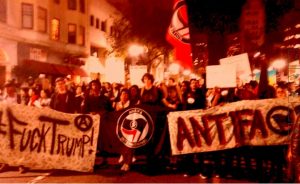Posted by Jack, from the website Beautiful Trouble
You want to be an action designer, like a movie director.”
 If you design your action well, you can force your target into a situation where they have to respond, but have no good options — where they’re damned if they do, damned if they don’t. In fact, many actions with concrete goals (such as blockades, sit-ins, tree-sits, etc.) require such a “decision dilemma” in order to be successful.
If you design your action well, you can force your target into a situation where they have to respond, but have no good options — where they’re damned if they do, damned if they don’t. In fact, many actions with concrete goals (such as blockades, sit-ins, tree-sits, etc.) require such a “decision dilemma” in order to be successful.
Consider the blockade of a building. A tactically effective blockade leaves your target with only two options: 1) negotiate with you / meet your demands, or 2) react with force (violence against you or arrest). That’s a decision dilemma. Don’t let your target walk out the back door, and don’t put yourself in a situation where they can wait you out with impunity. You must force a clear decision dilemma. Without it, you let your target and/or the police determine the success of your action, rather than calling the shots yourself. Be sure to cover all the exits — literally or figuratively.
Creative activists can adapt this tactical insight to force their target into a similar dilemma on the symbolic level.
Take Cindy Sheehan. In the summer of 2005, after the death of her son, Army Spc. Casey Sheehan, in the Iraq War, she camped out in front of President Bush’s Texas ranch where he had just begun a three-week vacation. Quoting Bush’s own words back to him, she vowed not to leave until he met with her to explain for what “noble cause” her son had died.
Once the media started covering the standoff, Bush was trapped in a decision dilemma: he was damned if he did meet with her, damned if he didn’t. Meeting with her would’ve been a media fiasco. Not meeting with her conceded her point. Either way he lost. In the end, he never met with Sheehan, and “Camp Casey” became one of the key watershed moments that turned American public opinion against the war.
Or consider the Whose Tea Party? action see CASE. GOP Congressmen gathered on the Boston Tea Party ship for a set-piece media stunt: tossing a trunk labelled “tax code” into the harbor. But they were suddenly confronted by a dinghy of activists — “the Working Family Life Raft” — in the water beneath them, pleading not to be swamped by the proposed flat tax. With cameras rolling, the target had two choices: either toss the tax code in and sink the raft (as they did) or back down on their declared intention to dispose of the tax code. By throwing it in and capsizing the raft, they played into the activists’ story that the GOP’s proposed tax reform would “sink the working family.” Backing down would also have undermined the GOP argument by symbolically conceding that the tax would be harmful to working families. As with Camp Casey, this decision dilemma was not a happy accident, but a key design element of the action.
Often, for this principle to work, you have to be prepared to wait out your opponent. Cindy Sheehan committed to camping outside Bush’s ranch for the duration of his vacation. She wasn’t going anywhere. It was his move, and he didn’t have one. Similarly, the Working Family Life Raft bobbed in the water, pleading for the GOP to spare working families while the media documented the event. Unlike a lot of actions, there were no security guards to clear them out. They could just wait, and the more the GOPers hesitated, the more they reinforced the protesters’ message.
Potential PitfallsAs with bear safety, so with activism: forcing someone into a corner can sometimes provoke a violent response. If your intention is to eliminate the flight option in a fight-or-flight scenario, then you need to take all necessary precautions to minimize the risk to you and your allies, should the target choose to lash out see PRINCIPLE: Take risks, but take care.

The correct way to treat rioters/looters:
https://www.thegatewaypundit.com/2020/08/dude-shooting-us-blm-militants-run-lives-milwaukee-homeowner-fires-warning-shots-protesters-neighborhood-video/